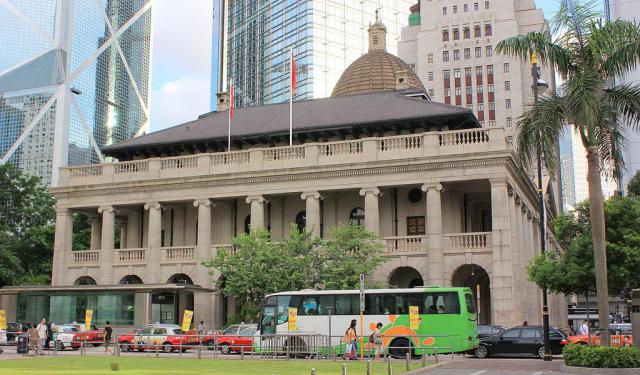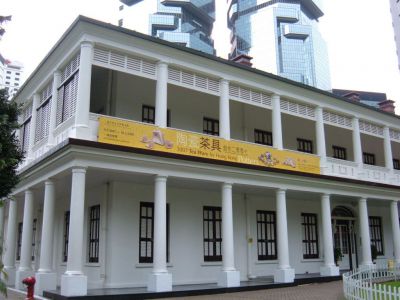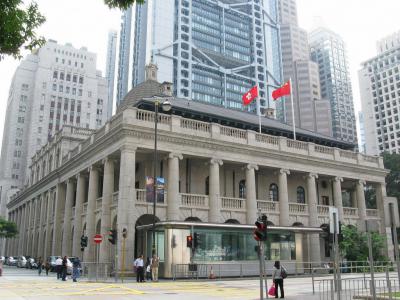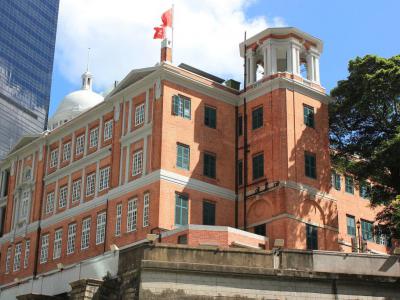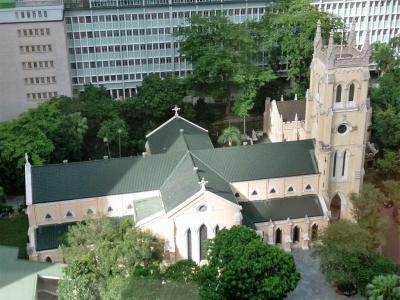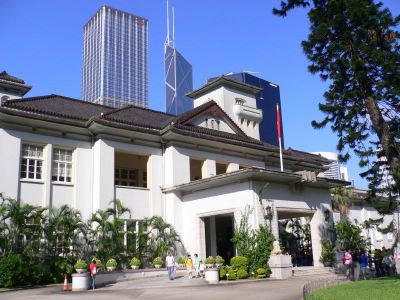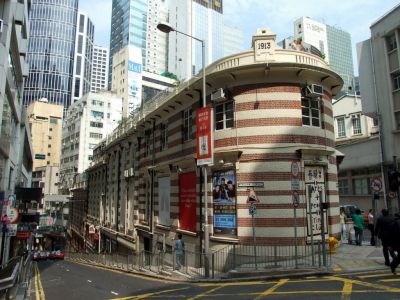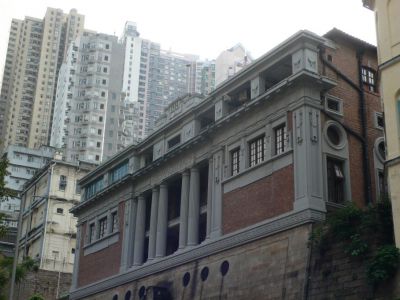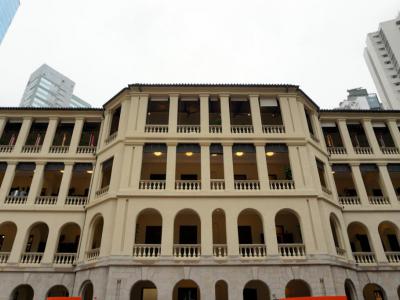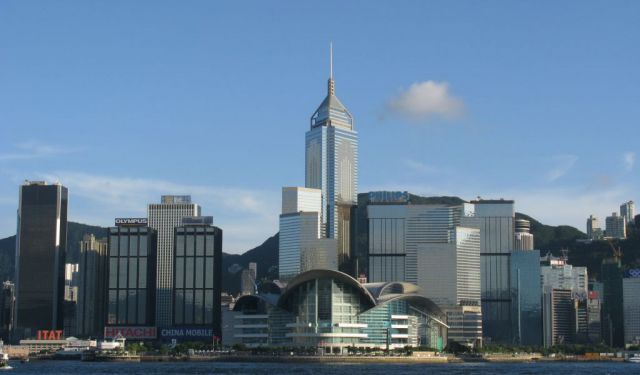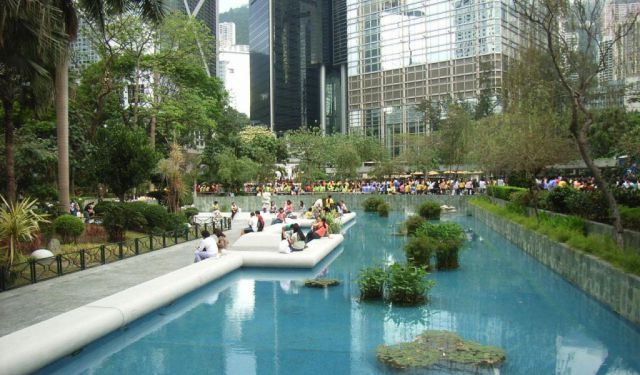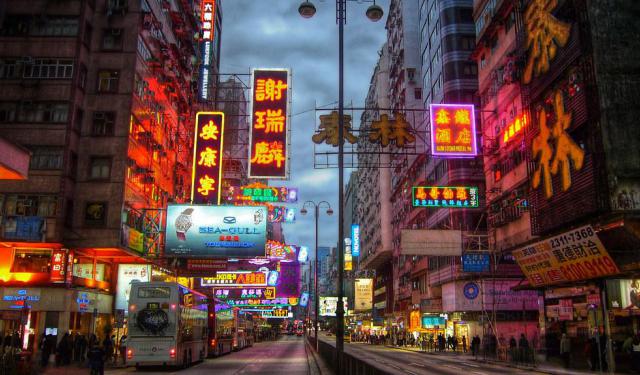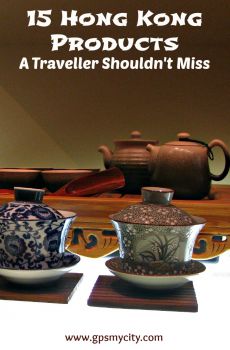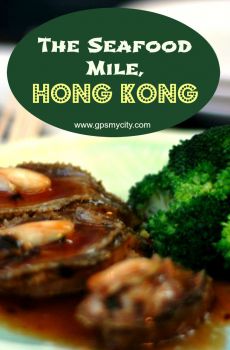Colonial Buildings in Central Hong Kong (Self Guided), Hong Kong
Having been a British colony for over a century, Hong Kong boasts a wealth of colonial architecture. The majority of old buildings, some designated national heritage objects, are concentrated in the Central part of the city.
The Flagstaff House Museum of Tea Ware is one such charming colonial edifice that once served as the residence of the Commander of the British forces. Today, it houses a remarkable collection of tea ware, showcasing the significance of tea culture in Hong Kong's history.
The Legislative Council Building is an iconic symbol of Hong Kong's political history. Its neoclassical architecture stands as a testament to the British colonial administration's influence on the region's governance.
The Court of Final Appeal, with its distinct red brick facade, is another prominent colonial-era structure. It has played a vital role in the city's judicial system and continues to do so today.
Saint John's Cathedral, a splendid Gothic-style church, is a spiritual oasis in the heart of Central Hong Kong. Its construction dates back to the mid-19th century and stands as a testament to the enduring presence of Christianity in the region.
Government House, an elegant mansion set amidst lush gardens, was once the official residence of British colonial governors. It now serves as the official residence of the Chief Executive of Hong Kong.
The Old Dairy Farm Depot, the Central Magistracy, and the Central Police Station are historic structures that have been repurposed to accommodate contemporary needs while preserving their colonial architectural charm.
More than just relics of the past, these colonial buildings are living testaments to Hong Kong's unique history. So, make sure to pay them a due visit on your trip to Hong Kong. The stories they hold and the beauty they exude are well worth it!
The Flagstaff House Museum of Tea Ware is one such charming colonial edifice that once served as the residence of the Commander of the British forces. Today, it houses a remarkable collection of tea ware, showcasing the significance of tea culture in Hong Kong's history.
The Legislative Council Building is an iconic symbol of Hong Kong's political history. Its neoclassical architecture stands as a testament to the British colonial administration's influence on the region's governance.
The Court of Final Appeal, with its distinct red brick facade, is another prominent colonial-era structure. It has played a vital role in the city's judicial system and continues to do so today.
Saint John's Cathedral, a splendid Gothic-style church, is a spiritual oasis in the heart of Central Hong Kong. Its construction dates back to the mid-19th century and stands as a testament to the enduring presence of Christianity in the region.
Government House, an elegant mansion set amidst lush gardens, was once the official residence of British colonial governors. It now serves as the official residence of the Chief Executive of Hong Kong.
The Old Dairy Farm Depot, the Central Magistracy, and the Central Police Station are historic structures that have been repurposed to accommodate contemporary needs while preserving their colonial architectural charm.
More than just relics of the past, these colonial buildings are living testaments to Hong Kong's unique history. So, make sure to pay them a due visit on your trip to Hong Kong. The stories they hold and the beauty they exude are well worth it!
How it works: Download the app "GPSmyCity: Walks in 1K+ Cities" from Apple App Store or Google Play Store to your mobile phone or tablet. The app turns your mobile device into a personal tour guide and its built-in GPS navigation functions guide you from one tour stop to next. The app works offline, so no data plan is needed when traveling abroad.
Colonial Buildings in Central Hong Kong Map
Guide Name: Colonial Buildings in Central Hong Kong
Guide Location: Hong Kong » Hong Kong (See other walking tours in Hong Kong)
Guide Type: Self-guided Walking Tour (Sightseeing)
# of Attractions: 8
Tour Duration: 2 Hour(s)
Travel Distance: 2.5 Km or 1.6 Miles
Author: emma
Sight(s) Featured in This Guide:
Guide Location: Hong Kong » Hong Kong (See other walking tours in Hong Kong)
Guide Type: Self-guided Walking Tour (Sightseeing)
# of Attractions: 8
Tour Duration: 2 Hour(s)
Travel Distance: 2.5 Km or 1.6 Miles
Author: emma
Sight(s) Featured in This Guide:
- Flagstaff House Museum of Tea Ware
- Legislative Council Building
- Court of Final Appeal
- St. John's Cathedral
- Government House
- Old Dairy Farm Depot
- Central Magistracy
- Central Police Station
1) Flagstaff House Museum of Tea Ware
Once serving as the home of the Commander of the British forces during the colonial era, Flagstaff House has since been repurposed and transformed into today’s Museum of Tea Ware. Constructed in 1846 and situated on Cotton Tree Drive within the grounds of Hong Kong Park, it stands as Hong Kong’s oldest surviving example of Western-style architecture.
Originally known as Headquarters House until 1932, its location was deliberately chosen: a small bluff overlooking the barracks, Queen’s Road, and the waterfront. The design reflects the elegance of the Greek Revival style and is attributed either to Murdoch Bruce or Lieutenant Bernard Collinson. Major-General George Charles D’Aguilar was its first occupant.
During World War II, Flagstaff House sustained damage during Japanese bombings but was later repaired and used as the Commandant’s residence. After the war, it once again housed the Commander until 1978, when a new residence on Barker Road took over this role. The building was subsequently handed to the Hong Kong Government and, in 1981, came under the administration of the Urban Council.
Recognized as a declared monument in 1989, Flagstaff House underwent significant restoration to return it to its mid-19th-century appearance. In 1984, the Flagstaff House Museum of Tea Ware was established as a branch of the Hong Kong Museum of Art. The museum highlights the history, culture, and craftsmanship of Chinese tea preparation, presenting an exceptional collection that includes Yixing teapots from Jiangsu province—among them the world’s oldest surviving teapot. Visitors will also find fine porcelain tea sets, Qing dynasty brewing vessels, lacquerware trays, calligraphy related to tea culture, and rotating thematic exhibitions that explore everything from regional tea traditions to contemporary interpretations of teaware design.
Originally known as Headquarters House until 1932, its location was deliberately chosen: a small bluff overlooking the barracks, Queen’s Road, and the waterfront. The design reflects the elegance of the Greek Revival style and is attributed either to Murdoch Bruce or Lieutenant Bernard Collinson. Major-General George Charles D’Aguilar was its first occupant.
During World War II, Flagstaff House sustained damage during Japanese bombings but was later repaired and used as the Commandant’s residence. After the war, it once again housed the Commander until 1978, when a new residence on Barker Road took over this role. The building was subsequently handed to the Hong Kong Government and, in 1981, came under the administration of the Urban Council.
Recognized as a declared monument in 1989, Flagstaff House underwent significant restoration to return it to its mid-19th-century appearance. In 1984, the Flagstaff House Museum of Tea Ware was established as a branch of the Hong Kong Museum of Art. The museum highlights the history, culture, and craftsmanship of Chinese tea preparation, presenting an exceptional collection that includes Yixing teapots from Jiangsu province—among them the world’s oldest surviving teapot. Visitors will also find fine porcelain tea sets, Qing dynasty brewing vessels, lacquerware trays, calligraphy related to tea culture, and rotating thematic exhibitions that explore everything from regional tea traditions to contemporary interpretations of teaware design.
2) Legislative Council Building
The Former Supreme Court Building of Hong Kong, later known as the Legislative Council Building, is a landmark of considerable historical significance. Completed in 1912, it served as the Supreme Court for more than seven decades before the judiciary relocated in 1985, at which point the building was reassigned to the Legislative Council.
Its architectural design was entrusted to Sir Aston Webb, the British architect best known for the eastern façade of Buckingham Palace. Working with Ingress Bell, he created a dignified neo-classical structure on newly reclaimed land. The three-storey granite exterior is supported by Ionic columns, while the rooftop is crowned with a statue of Themis, the blindfolded Greek goddess of justice and law—an identical counterpart to the figure atop London’s Old Bailey.
In 1978, significant restoration work was carried out in response to the construction of the Mass Transit Railway nearby. The building went on to house the Legislative Council until 2011, and, after further adaptation, became the home of the Court of Final Appeal in 2015. Today, as one of Hong Kong’s declared monuments, it remains an enduring symbol of the city’s legal and colonial heritage.
Its architectural design was entrusted to Sir Aston Webb, the British architect best known for the eastern façade of Buckingham Palace. Working with Ingress Bell, he created a dignified neo-classical structure on newly reclaimed land. The three-storey granite exterior is supported by Ionic columns, while the rooftop is crowned with a statue of Themis, the blindfolded Greek goddess of justice and law—an identical counterpart to the figure atop London’s Old Bailey.
In 1978, significant restoration work was carried out in response to the construction of the Mass Transit Railway nearby. The building went on to house the Legislative Council until 2011, and, after further adaptation, became the home of the Court of Final Appeal in 2015. Today, as one of Hong Kong’s declared monuments, it remains an enduring symbol of the city’s legal and colonial heritage.
3) Court of Final Appeal
Housed in the Former French Mission Building, the Court of Final Appeal of Hong Kong is the highest appellate court in the city, holding ultimate authority over all local laws. It was established on July 1, 1997, the day Hong Kong’s sovereignty transferred from the United Kingdom to China, replacing the Judicial Committee of the Privy Council in London as the final court of appeal. In 2015, the court moved from the Former French Mission Building to the restored Old Supreme Court Building on Jackson Road.
The court’s former home, the Former French Mission Building, was originally a mansion known as Johnston House. The present structure was completed by the French Mission, designed with inspiration from “Beaconsfield,” a neighboring residence once standing nearby. Its red-brick facade, granite detailing, and Edwardian neo-classical style give it a distinctive presence on the hillside, while the podium beneath accommodates the steep contours of Government Hill.
Over the years, the building has served multiple purposes—including housing the French Mission, government offices, cultural institutions, and, from 1997 to 2015, the Court of Final Appeal. Today it forms part of Hong Kong’s wider legal center and is generally used by legal-related organizations rather than as a public museum space. While the interior is not normally open for casual visits, the exterior and its surroundings remain accessible.
The court’s former home, the Former French Mission Building, was originally a mansion known as Johnston House. The present structure was completed by the French Mission, designed with inspiration from “Beaconsfield,” a neighboring residence once standing nearby. Its red-brick facade, granite detailing, and Edwardian neo-classical style give it a distinctive presence on the hillside, while the podium beneath accommodates the steep contours of Government Hill.
Over the years, the building has served multiple purposes—including housing the French Mission, government offices, cultural institutions, and, from 1997 to 2015, the Court of Final Appeal. Today it forms part of Hong Kong’s wider legal center and is generally used by legal-related organizations rather than as a public museum space. While the interior is not normally open for casual visits, the exterior and its surroundings remain accessible.
4) St. John's Cathedral
Of the few cathedrals in Hong Kong, the Cathedral Church of Saint John the Evangelist – commonly known as Saint John’s Cathedral – is the oldest. Like Holy Trinity Cathedral and All Saints’ Cathedral, Saint John’s is Anglican. Completed in 1849 and consecrated in 1852, it is not only the oldest cathedral in Hong Kong but also the oldest Anglican church in the Far East.
Designed in the English Gothic Revival style, the cathedral is built from stucco and wood, with a simple cross-shaped plan and an understated, early English–inspired interior that contrasts with the surrounding skyscrapers. Inside, memorial tablets, stained-glass windows and a prominent chancel recall its long role as the main Anglican church for the city. Today it serves as the cathedral of the Anglican Diocese of Hong Kong Island and the mother church of the Province of Hong Kong Sheng Kung Hui.
The building has also lived through some of Hong Kong’s hardest moments. During the Japanese occupation in World War II, Saint John’s was turned into a club for Japanese forces, and many original fittings – including stained glass designed by William Morris’s firm – were stripped out. After the war, services resumed and the cathedral was gradually restored; in 1996 it was declared a monument, recognizing its importance as the oldest surviving Western ecclesiastical building in Hong Kong.
Visitors are welcome to attend services at Saint John’s. The cathedral now holds multiple services across Saturdays and Sundays, with a quieter lunchtime meditation on Mondays that offers a brief pause in the middle of the working week. Wednesday lunchtime performances are often held here, and there is also a small cafe on the cathedral grounds, The Nest, serving drinks and light snacks.
Designed in the English Gothic Revival style, the cathedral is built from stucco and wood, with a simple cross-shaped plan and an understated, early English–inspired interior that contrasts with the surrounding skyscrapers. Inside, memorial tablets, stained-glass windows and a prominent chancel recall its long role as the main Anglican church for the city. Today it serves as the cathedral of the Anglican Diocese of Hong Kong Island and the mother church of the Province of Hong Kong Sheng Kung Hui.
The building has also lived through some of Hong Kong’s hardest moments. During the Japanese occupation in World War II, Saint John’s was turned into a club for Japanese forces, and many original fittings – including stained glass designed by William Morris’s firm – were stripped out. After the war, services resumed and the cathedral was gradually restored; in 1996 it was declared a monument, recognizing its importance as the oldest surviving Western ecclesiastical building in Hong Kong.
Visitors are welcome to attend services at Saint John’s. The cathedral now holds multiple services across Saturdays and Sundays, with a quieter lunchtime meditation on Mondays that offers a brief pause in the middle of the working week. Wednesday lunchtime performances are often held here, and there is also a small cafe on the cathedral grounds, The Nest, serving drinks and light snacks.
5) Government House
Government House serves as the official residence of the Chief Executive of Hong Kong. The structure was built in 1855 in the Colonial Renaissance style, but during the Japanese occupation it underwent significant remodeling. Today, the building displays a hybrid Japanese–Neoclassical appearance, featuring a tower and roof elements added in 1944 by Japanese architect Seichi Fujimura.
During British rule, Government House served as the official residence of the Governors of Hong Kong from 1855 to 1997. Of the 28 British Governors, 25 lived in the residence during their terms, making it one of the most historically symbolic sites of the colonial administration.
The structure has been extensively renovated in recent decades, and an elaborate koi pond has been added to its landscaped grounds. A lesser-known fact is that the garden occasionally opens to the public for special flower-viewing event.
During British rule, Government House served as the official residence of the Governors of Hong Kong from 1855 to 1997. Of the 28 British Governors, 25 lived in the residence during their terms, making it one of the most historically symbolic sites of the colonial administration.
The structure has been extensively renovated in recent decades, and an elaborate koi pond has been added to its landscaped grounds. A lesser-known fact is that the garden occasionally opens to the public for special flower-viewing event.
6) Old Dairy Farm Depot
The Old Dairy Farm Depot is one of Central’s most distinctive surviving colonial buildings, instantly recognizable by its red-and-white “blood and bandages” brickwork. Built in the 1890s as a low-rise cold-storage warehouse for Dairy Farm, it once handled ice, milk, meat, and even winter clothing at a time when refrigeration was still a luxury in Hong Kong. By the 1910s, the depot had expanded to include a dairy shop, meat-smoking rooms, offices, and a residence for the company’s general manager, eventually serving as Dairy Farm’s headquarters until the company relocated in the 1970s.
After a brief period of abandonment, the building found a new role in the 1980s. The Foreign Correspondents’ Club moved into the North Block, creating one of the city’s most storied private press clubs, while the Hong Kong Fringe Club transformed the South Block into a lively arts venue hosting exhibitions, concerts, theater, and cultural events.
Today, the Old Dairy Farm Depot stands as a rare low-rise survivor among Central’s towers. Its late Victorian eclectic architecture has earned it both Grade I historic status and a Hong Kong Heritage Award for conservation. While the FCC remains members-only, the Fringe Club offers regular public programs, making the depot a compelling stop for anyone interested in mixing heritage architecture with Hong Kong’s contemporary cultural scene.
After a brief period of abandonment, the building found a new role in the 1980s. The Foreign Correspondents’ Club moved into the North Block, creating one of the city’s most storied private press clubs, while the Hong Kong Fringe Club transformed the South Block into a lively arts venue hosting exhibitions, concerts, theater, and cultural events.
Today, the Old Dairy Farm Depot stands as a rare low-rise survivor among Central’s towers. Its late Victorian eclectic architecture has earned it both Grade I historic status and a Hong Kong Heritage Award for conservation. While the FCC remains members-only, the Fringe Club offers regular public programs, making the depot a compelling stop for anyone interested in mixing heritage architecture with Hong Kong’s contemporary cultural scene.
7) Central Magistracy
The Central Magistracy was completed in 1914, standing on the original site of the first Hong Kong Magistracy built by the British. That earlier structure, dating to around 1847, was one of the first government buildings erected after the British arrival in Hong Kong and was later demolished to make way for the new magistracy and its additional blocks.
The present building features a Greek Revival design, distinguished by its imposing façade and prominent pillars, giving it an overall majestic appearance. Its walls are constructed of granite blocks, and the inclusion of a basement in the new design—unusual for the time—caused considerable delays during construction. One lesser-known detail is that the building’s heavy classical style was chosen deliberately to convey the authority and stability of the colonial legal system.
The Central Magistracy, together with Victoria Prison and the Central Police Station, forms the historic Central Police Station Compound. The magistracy ceased judicial operations in 1978 and was subsequently used by the police for various administrative purposes. In the 2000s, the building was incorporated into the large-scale revitalization project that transformed the entire compound into Tai Kwun – Center for Heritage and Arts, which opened to the public in 2018.
Today, parts of the Central Magistracy’s interior are accessible as heritage exhibition spaces within Tai Kwun, allowing visitors to explore the building’s restored corridors and interpretive displays, while its exterior remains one of the finest examples of Greek Revival civic architecture in Central.
The present building features a Greek Revival design, distinguished by its imposing façade and prominent pillars, giving it an overall majestic appearance. Its walls are constructed of granite blocks, and the inclusion of a basement in the new design—unusual for the time—caused considerable delays during construction. One lesser-known detail is that the building’s heavy classical style was chosen deliberately to convey the authority and stability of the colonial legal system.
The Central Magistracy, together with Victoria Prison and the Central Police Station, forms the historic Central Police Station Compound. The magistracy ceased judicial operations in 1978 and was subsequently used by the police for various administrative purposes. In the 2000s, the building was incorporated into the large-scale revitalization project that transformed the entire compound into Tai Kwun – Center for Heritage and Arts, which opened to the public in 2018.
Today, parts of the Central Magistracy’s interior are accessible as heritage exhibition spaces within Tai Kwun, allowing visitors to explore the building’s restored corridors and interpretive displays, while its exterior remains one of the finest examples of Greek Revival civic architecture in Central.
8) Central Police Station
The Central Police Station occupies a site first developed in the mid-19th century after the arrival of the British. It became one of the earliest areas where colonial authorities established key institutions, forming a cluster that included the Central Police Station building, the Victoria Prison compound, and the Central Magistracy. Together, these structures shaped the administrative core of early Victoria City.
The oldest surviving element of the station is a three-story barrack block built in 1864 beside the Victoria Prison. This early block served as accommodation and workspace for officers stationed in the area. In 1905, it was expanded with a fourth story, and additional extensions followed between 1910 and 1925. These construction phases aligned with a period of rapid population growth, as large numbers of migrants arrived from mainland China and new police facilities were needed to support increased demands on law enforcement.
Throughout its history, the station underwent multiple rounds of modification, responding to social change, shifting policing methods, and the wider development of Central as Hong Kong’s commercial and civic hub. What began as a cluster of modest service buildings gradually evolved into a more substantial complex. The Central Police Station ultimately comprised seven blocks, each with its own function, and together they formed one of the territory’s most important government sites for more than a century.
The oldest surviving element of the station is a three-story barrack block built in 1864 beside the Victoria Prison. This early block served as accommodation and workspace for officers stationed in the area. In 1905, it was expanded with a fourth story, and additional extensions followed between 1910 and 1925. These construction phases aligned with a period of rapid population growth, as large numbers of migrants arrived from mainland China and new police facilities were needed to support increased demands on law enforcement.
Throughout its history, the station underwent multiple rounds of modification, responding to social change, shifting policing methods, and the wider development of Central as Hong Kong’s commercial and civic hub. What began as a cluster of modest service buildings gradually evolved into a more substantial complex. The Central Police Station ultimately comprised seven blocks, each with its own function, and together they formed one of the territory’s most important government sites for more than a century.
Walking Tours in Hong Kong, Hong Kong
Create Your Own Walk in Hong Kong
Creating your own self-guided walk in Hong Kong is easy and fun. Choose the city attractions that you want to see and a walk route map will be created just for you. You can even set your hotel as the start point of the walk.
Causeway Bay Walking Tour
If you're looking for a taste of Hong Kong's energetic urban life, Causeway Bay is the place to be. Well known for its mega shopping malls and skyscrapers “rubbing shoulders” with rustic streets and picturesque corners, this bustling district is one of the city's most popular shopping and entertainment hubs.
The foremost among its landmarks is Times Square. Despite the name,... view more
Tour Duration: 1 Hour(s)
Travel Distance: 2.8 Km or 1.7 Miles
The foremost among its landmarks is Times Square. Despite the name,... view more
Tour Duration: 1 Hour(s)
Travel Distance: 2.8 Km or 1.7 Miles
Downtown Introduction Walking Tour
Hong Kong is a city defined by contrasts—towering glass skylines rising beside quiet temples and centuries of culture. Even its name, from the Cantonese Heung Gong, meaning “Fragrant Harbor”, hints at its early role as a trading point for incense woods and aromatic goods moving through the Pearl River Delta. What began as the name of a small village near the present-day Aberdeen area... view more
Tour Duration: 2 Hour(s)
Travel Distance: 3.7 Km or 2.3 Miles
Tour Duration: 2 Hour(s)
Travel Distance: 3.7 Km or 2.3 Miles
Kowloon Walking Tour
The most popular part of Hong Kong outside the Downtown area, the Kowloon district is also one of the most densely populated neighborhoods on the planet, packed to the brim with all sorts of shops and restaurants. Situated north of the Hong Kong island, Kowloon can be described as the mirror of Central Hong Kong.
Some of the top attractions in Kowloon are set around the dazzling Nathan Road (a... view more
Tour Duration: 2 Hour(s)
Travel Distance: 4.6 Km or 2.9 Miles
Some of the top attractions in Kowloon are set around the dazzling Nathan Road (a... view more
Tour Duration: 2 Hour(s)
Travel Distance: 4.6 Km or 2.9 Miles
Useful Travel Guides for Planning Your Trip
15 Hong Kong Products A Traveller Shouldn't Miss
The image of Hong Kong has been much popular with tourists since the late 1960s-early 70s, in large part due to the Bruce Lee movies, and has remained so after the city was ceded back to China in 1997. Still, despite such popularity, there're quite a few things, originally made in Hong Kong,...
The Seafood Mile, Hong Kong
Cheung Chau is one of a cluster of Islands off the coast of Hong Kong. It has a fishing harbor to the front, which is lit up at night with tiny green, blue and white boat lights. The harbor is overlooked by many restaurants and street food can be bought from many vendors, who line up throwing an...
The Most Popular Cities
/ view all
